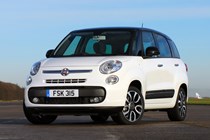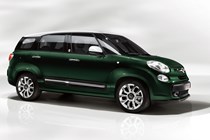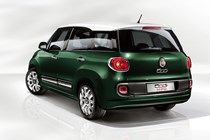
Fiat 500L MPW Estate engines, drive and performance

With no engine from launch offering more than 105bhp, the 500L MPW is certainly no ball of fire, but that’s in keeping with the soft and comfortable ethos of the car. Unlike MINI selling Cooper S versions of its competing Countryman range, there are no current plans to release an Abarth Fiat 500L MPW performance version, although the Italian firm didn’t rule out the possibility either.
Depending upon your needs, turbocharged petrol and diesel engines are on offer, all with manual gearboxes. If an automatic transmission is a necessity then you’re limited to Fiat’s MTA gearbox on the smaller of the diesels.
Petrol power
Fiat’s familiar TwinAir two-cylinder petrol engine kicks off the 500L MPW range but unlike the unit in its smaller 500 namesake, here it delivers a healthy 105bhp at a high 5,500 rpm. With 145Nm of torque produced at 2,000 rpm, the TwinAir-powered MPW can reach 111mph and get to 62mph in 13.0 seconds. At 54.7mpg fuel efficiency is good for a petrol engine hauling a car of this size around, although the six-speed manual gearbox has to be worked to get the best out of it. Do so and it should emit just 112g/km of CO2.
Diesel derivatives
Two versions of the overhauled MultiJet II family of diesel motors are on offer in the MPW too; a 1.3-litre with 85bhp and 200Nm of torque at 1,500 rpm, the larger 1.6-litre with 105bhp and 320Nm. The larger engine produces its pulling power from 1,750 rpm making it particularly well-suited for a variety of urban and motorway traffic conditions, although there is an initial lag in performance until the turbo comes on song. This can be swiftly overcome by dropping a gear, of course.
With a top speed of 112mph (104mph for the 1.3) and reaching 62mph in 12.2 seconds (versus 15.4 for the smaller engine), many will find the larger engine suits them best, despite being 3.3mpg less efficient than the 1.3 at 60.3mpg. On an initial drive of the 1.6-litre, encompassing a mix of motorways and urban stretches, 48mpg was easily achieved.
Manual gearboxes are standard on the diesel range; five-speeds for the 1.3-litre, six for the 1.6-litre. The smaller engine can also be fitted with a five-speed automatic at extra cost.
Two further engines, both with 120bhp, will arrive later, more than likely in early 2014. One is a more powerful version of the 1.6-litre diesel, while the other is the petrol-fed 1.4-litre T-Jet. Performance and efficiency figures will be announced nearer the on-sale date.
Despite its jellymould appearance, the 500L MPW does not wallow along the road as though you’re at the helm of a mobile blancmange. That said, it’s unlikely to set your pulse racing or leave you with a huge grin on your face, but it does provide safe and secure handling for up to seven occupants.
Fiat has modified the 500L’s suspension in its transition into the MPW including fitting different anti-roll bars. As a result the body of the car doesn’t list ship-like as you take sweeping bends but due to the soft, flat nature of the comfortable seats you do feel your own body being pulled by gravitational forces. More bolstering on the seat sides would help here.
Grippy tyres ensure cornering is secure with little adjustment of the wheel required to correct the turn mid-way through bends, although there’s little feel from the road transmitted to the driver’s hands. There’s more weight to the steering than in the smallest 500, as befitting the MPW’s size, but it never feels heavy or cumbersome.
Opting for larger 17-inch alloy wheels may provide some additional dynamism to the driving experience but with lower profile tyres the ride quality, one of the MPW’s strengths, is likely to suffer.































